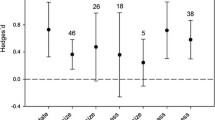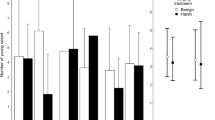Abstract
Life-history components may be food-limited. We supplemented food to 18 Ural owl, Strix uralensis, nests during the nestling period. Food supplementation led to a higher somatic condition in the female parent, but effects in males were moderate. Parents delivered less food to fed nests than to control nests. Offspring survival and fledging condition did not differ between control and fed nests. In the season following food supplementation, fed pairs bred 1 week earlier than control pairs and, coupled to this advance in laying date, fed pairs produced 0.6 eggs more than control pairs. This is the first evidence that food limitation in the current season may constrain next season’s reproduction. Such carry-over effects of food-limitation may have important consequences for population dynamics.


Similar content being viewed by others
References
Arcese P, Smith JNM (1988) Effects of population density and supplemental food on reproduction in Song Sparrows. J Anim Ecol 57:119–136
Brommer JE, Pietiäinen H, Kolunen H (1998) The effect of age at first breeding on Ural Owl lifetime reproductive success and fitness under cyclic food conditions. J Anim Ecol 67:359–369
Brommer JE, Pietäinen H, Kokko H (2002a) Cyclic variation in seasonal recruitment and the evolution of the seasonal decline in Ural owl clutch size. Proc R Soc Lond B 269:647–654
Brommer JE, Pietiäinen H, Kolunen H (2002b) Reproduction and survival in a variable environment: the Ural owl and the three-year vole cycle. Auk 119:194–201
Brommer JE, Karell P, Painter JN, Pihlaja T, Primmer CR, Pietiäinen H (2003) Ural owl sex allocation and parental investment under poor food conditions. Oecologia 137:140–147
Daan S, Dijkstra C, Tinbergen JM (1990) Family planning in the kestrel (Falco tinnunculus): the ultimate control in covariation of laying date and clutch size. Behavior 114:83–116
Drent RH, Daan S (1980) The prudent parent: energetic adjustments in avian breeding. Ardea 68:225–252
Fridolfsson A-K, Ellegren H (1999) A simple and universal method for molecular sexing of non-ratite birds. J Avian Biol 30:116–121
Garcia PFJ, Merkle MS, Barclay RMR (1993) Energy allocation to reproduction and maintenance in Mountain Bluebirds (Sialia curuucoides): a food supplementation experiment. Can J Zool 71:1352–2357
Gill VA, Hatch SA (2002) Components of productivity in black-legged kittiwakes Rissa tridactyla: response to supplemental feeding. J Avian Biol 33:113–126
Grieco F, Noordwijk AJ van, Visser ME (2001) Evidence for the effect of learning on timing of reproduction in blue tits. Science 296:136–138
Hipkiss T, Hörnfeldt B, Eklund U, Berlin S (2002) Year-dependent sex-biased mortality in supplementary-fed Tengmalm’s owl nestlings. J Anim Ecol 71:693–699
Högstedt G (1981) Effects of additional food on the reproductive success in the magpie (Pica pica). J Anim Ecol 50:219–229
Korpimäki E (1984) Population dynamics of birds of prey in relation to fluctuations in small mammal populations in western Finland. Ann Zool Fenn 21:287–293
Korpimäki E, Wiehn J (1998) Clutch size of kestrels: seasonal decline and experimental evidence for food limitation under fluctuating food conditions. Oikos 83: 259–272.
Lessels CM (1991) The evolution of life histories. In J.R. Krebs and N.B. Davies (eds.) Behavioural ecology, 3rd edn. Blackwell, Cambridge, pp 32–68
Martin TE (1987) Food as a limit on breeding birds: a life-history perspective. Annu Rev Ecol Syst 18:453–487
Meijer T, Daan S, Hall M (1990) Family planning in the kestrel (Falco tinnunculus): the proximate control of covariation of laying date and clutch size. Behaviour 114:117–136
Noordwijk AJ van, Jong G de (1986) Acquisition and allocation of resources: their influence on variation in life history tactics. Am Nat 126:137–142
Norrdahl K (1995) Population cycles in northern small mammals. Biol Rev 70:621–637
Pietiäinen H (1989) Seasonal and individual variation in the production of offspring in the Ural owl Strix uralensis. J Anim Ecol 58: 905–920
Pietiäinen H, Kolunen H (1993) Female body condition and breeding of the Ural owl Strix uralensis. Funct Ecol 7:726–735
Pinheiro JC, Bates DM (2000) Mixed-effects models in S and S-PLUS. Springer, New York Berlin Heidelberg
Richner H (1992) The effect of extra food on fitness in breeding carrion crows. Ecology 73:330–335
Roff DA (1992) The evolution of life histories. Theory and analysis. Chapman and Hall, New York
Rohner C (1996) The numerical response of great horned owls during a peak and decline of the snowshoe hare cycle: consequences of non-territorial floaters on demography. J Anim Ecol 65:359–370
Rowe L, Ludwig D, Schluter D (1994) Time, condition and the seasonal decline of avian clutch size. Am Nat 143:698–722
Royama T (1992) Analytical population dynamics. Chapman and Hall, London
Saurola P (1987) Mate and nest-site fidelity in Ural and Tawny Owls. In: Nero RW, Clark RJ, Knapton RJ, Hamre RH (eds) Biology and conservation of northern forest owls. Symp Proc USDA Forest Service, General Technical Report RM–142, pp 81–86
Stearns SC (1992) The evolution of life histories. Oxford University Press, Oxford.
Stenseth NC, Chan K-S, Framstad E, Tong H (1998a) Phase- and density dependent population dynamics in Norwegian lemmings: interaction between deterministic and stochastic processes. Proc R Soc Lond B 265:1957–1968
Stenseth NC, Falck W, Chan K–S, Bjørnstad ON, O’Donoghue M, Tong H, Boonstra R, Boutin S, Krebs CJ, Yoccoz NG (1998b) From patterns to processes: Phase and density dependencies in the Canadian lynx cycle. Proc Natl Acad Sci USA 95:15430–15435
Wiebe KL, Bortolotti GR (1995) Food-dependent benefits of hatching asynchrony in American kestrels Falco sparverius. Behav Ecol Sociobiol 36:49–57
Wiehn J, Korpimäki E (1997) Food limitation on brood size: experimental evidence in the Eurasian kestrel. Ecology 78:2043–2050
Wiehn J, Korpimäki E (1998) Resource levels, reproduction and resistance to haematozoan infections. Proc R Soc Lond B 265:1197–1201
Acknowledgements
All experiments described in this paper were approved by the ethical board for animal experiments. We thank Nina Blomqvist, Inka Plitt, Heini Roschier, Jodie Painter, Henk-Jan Koning, Kristian Lindqvist and especially Tuomo Pihlaja and Heikki Kolunen for assistance in the field. Two anonymous reviewers are thanked for their detailed comments. This study was supported by the Academy of Finland (H.P., J.E.B.) and the Finnish Cultural Foundation (J.E.B., P.K.).
Author information
Authors and Affiliations
Corresponding author
Rights and permissions
About this article
Cite this article
Brommer, J.E., Karell, P. & Pietiäinen, H. Supplementary fed Ural owls increase their reproductive output with a one year time lag. Oecologia 139, 354–358 (2004). https://doi.org/10.1007/s00442-004-1528-0
Received:
Accepted:
Published:
Issue Date:
DOI: https://doi.org/10.1007/s00442-004-1528-0




